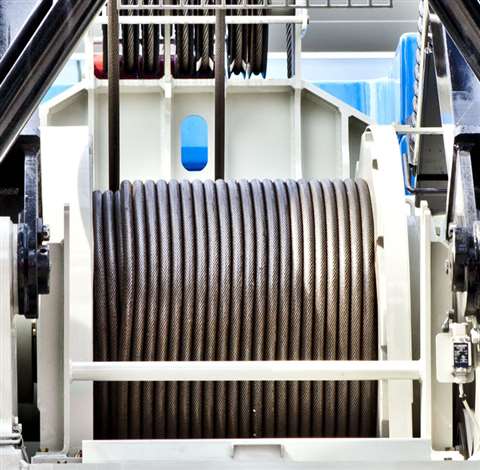Ropes: stronger together
15 November 2016

Crane manufacturers explain to Katherine Weir the reasons behind the move to synthetic rope while Cris Seidenather at Lebus International Engineers offers advice of how easy winch refurbishment can be
Recent developments in the rope industry have seen many crane manufacturers moving away from steel/wire and moving towards synthetic ropes for hoisting operations. This is highlighted not only in crane manufacturer choice but also in the literature surrounding the subject.
Fédération Européenne de la Manutention (FEM) is working on a guidance paper for the safe use of synthetic fibre ropes in mobile cranes. FEM product group Cranes and Lifting Equipment is working on the publication titled Safe Use of High Performance Synthetic Fibre Ropes on Mobile Cranes.
For steel wire ropes, there are decades of experience and international standards, for example, ISO 4309. There is no standard regarding design and discard criteria for high performance synthetic fibre rope used on mobile cranes, FEM says.
Klaus Meissner, FEM mobile crane president, says, “Modern fibre ropes offer very attractive technical properties for mobile cranes, nevertheless, there are a number of points which crane operators need to consider when switching from wire to fibre ropes.”
So what are the reasons for the jump to synthetic rope? Crane manufacturer Liebherr explains the reasons for the development of its new SoLite rope. “The practical requirements of cranes with increasingly higher hoisting heights and maximum load capacities means that a realignment in the rope and crane design is needed,” says a Liebherr spokesperson.
To fill this need, Liebherr joined forces with Austria-based rope manufacturer Teufelberger to create a high-strength synthetic fibre rope for crane operation. The joint venture began seven years ago and has resulted in SoLite, designed by Liebherr engineers from its components division, tower cranes, mobile, crawler and maritime cranes.
The rope was shown for the first time in April at the Bauma, Munich, exhibition and is now in the testing stages of development.
Benefits of this new design are said by Liebherr to include maximum weight savings of about 80 percent compared with steel rope, no rope lubrication, a long service life and clear discard criteria. The SoLite rope has different coloured rope that wears at different rates so crane operators can easily see when the rope has to be replaced, as well as electronic condition monitoring.
A Liebherr spokesperson adds, “The crane operator can recognise easily and reliably when the rope must be replaced. The jacket wears in a predefined pattern, making the red supporting parts visible. The discarding state can therefore be recognised without aids before there is any damage to the rope’s load bearing parts.”
For USA-based crane manufacturer Manitowoc wire rope has been the answer for its all terrain (AT) cranes, using 13 to 24 millimetre wire ropes for both the main and auxiliary hoists depending on the crane size and standard. The company is now introducing a new rope.
Andreas Cremer, global director for all terrain cranes at Manitowoc, says, “We are currently in the process of introducing synthetic ropes to our AT cranes - we already offer them as an option in the USA on our RT [rough terrain] and TM [truck mounted] products. This K-100 rope from Samson has a slight increase in diameter but it can be used with the same sheaves.”
The biggest advantages of using synthetic rope, the manufacturer says, are the lower weight, making it easier to handle, and the fact that the synthetic rope does not need to be greased.
Cremer adds, “The longer rope life is a benefit and certain problems known from wire ropes like diving, birdcage problems, twisting and corrosion are non-existent. The crane keeps the same components when changing from wire rope to fibre ropes, but sharp edges potentially caused by the wire rope would need to be removed.”
Liebherr says that to meet the new requirements of the fibre rope, a special rope drum design is needed. The manufacturer has developed a rope drum to maximise the lifetime of the rope and guarantee a safe operation of the rope drive under all operation conditions. Other than that, the company says, there are no special requirements to the rope drive other than for steel ropes.
For Manitowoc, drums are offered and some of the cranes come equipped with a cable follower to aid in proper spooling. Cremer says, “While spooling is important on wire rope, the synthetic rope is more forgiving because even diving into lower layers doesn’t cause a problem whereas it would destroy a wire rope.”
Split sleeves bring new life to old winch drums
Cris Seidenather, managing director at Lebus International Engineers, explains to IC that winch refurbishment is much easier than you might think.
Smooth and efficient spooling of wire rope depends on the design of the winch drum being engineered to match both the construction of the wire rope being spooled and the application for which it is being used.
If you change the application, or bring in a new wire rope of a different construction, diameter or length, then your winch drum is unlikely to be a perfect fit any longer. If you are lucky, it might be adequate, but the lifespan of the rope or the drum is likely to be compromised.
Even with perfect spooling, the grooves on the drum face that control the behaviour of the rope will be gradually worn down eventually. With metal on metal, this cannot be prevented. Like the rope, the drum face is a wearing part. At some point, therefore, whether it is worn out or no longer fit for purpose, your winch drum will need replacing. Or will it?
Actually, no. Replacement is not usually necessary. Winch drums can be refurbished to as good as new very simply. You do not even have to send the winch back to the workshop for repairs. It can all be done in the field.
The grooving pattern on the face of a rope drum can be supplied on a pair of half shells, also referred to as split sleeves. When attached to the face of an old drum, they provide new guidance for rope spooling.
Split sleeves are an effective, speedy and economical solution for providing grooving on a smooth winch drum without buying a whole new drum. Subject to compliance with the technical requirements, any wire rope winch system can be retrofitted with grooved sleeves.
Lebus makes a single grooved outer sleeve to meet the exact specifications of the customer’s drum. The grooving is engineered to suit the specific wire rope that is being used. The sleeve is then cut laterally into two sections.
These split sleeves can then be either bolted or welded onto an existing drum, creating a new continuous groove around the drum. The sleeves can be helically grooved, like the thread of a screw, or for multi-layer spooling they will have the special grooving originally developed by Lebus where the groove is parallel to the flanges (side plates) except for two crossover points on opposing sides of the drum.
Split sleeves are also interchangeable. This means that the same winch can be used with different types of rope simply by changing the sleeves. You might need a more powerful motor to drive the winch system if greater demand is placed upon it by a bigger rope, but it is not necessary to change the whole drum if the split sleeves solution is adopted. In this way, split sleeves make the drum future-proof.
Specifying split sleeves
It is normal for rope selection to precede drum design. When Lebus engineers receive a customer enquiry, one of the first questions they ask the customer is: what rope will be used? Only when we know the rope dimensions and construction can we begin to set about designing the drum face, as the depth and width (pitch) of the continuous groove is tailored to the rope that is to be controlled.
The rope not only determines the size of the groove but it also determines the size of the drum. The application might determine how much space there is for a drum. If space is constrained, a smaller drum will spool rope in more layers. If there is space for a bigger drum, then fewer layers are required. However, the diameter of the drum (defined as D) is constrained by the diameter of the rope (defined as d). The D:d ratio will normally be in the range of 20:1 to 30:1, depending on application and the flexibility of the rope. The permissible ratio limit will usually be contained in the applicable norms of your region or industry. In mining, for example, D:d ratios of up to 120:1 are allowed – meaning very thin wires can be used on very fat drums.
For specifying split sleeves, it is necessary to know details of the rope to be used, the length between the flanges of the drum, the outside diameter of the drum and the direction of spooling. Your drum sleeve designer will also need to know the distance to the first fixed sheave and whether the rope joins the drum through one of the flanges or through the drum core.
Installation of split sleeves
If new split sleeves are being installed onto a drum, it is essential that any gap between the sleeves and the flanges are equal at each flange. In other words, the sleeves must be centred on the drum. Position the first sleeve on the drum so that the rope entry point on the sleeve lines up correctly with the rope entry point on the drum flange, as illustrated in Figure 1.
The sleeve must be aligned so that as the fixed end of the rope comes through the flange it fits directly onto the end-filler of the sleeve with no gap. This can be checked with a metre long sample section of rope or hose, to verify proper alignment.
Before bolting or welding each sleeve onto the drum, pressure must be applied with a hydraulic jack and a wooden or rubber mallet to ensure that both fit snugly.
When placing the second sleeve on the drum, check that the grooves all line up with the first sleeve. Check also the smoothness of the join between the two sleeves. Any sharp ends exposed should be ground down. A short length of metal tube, say 5 or 10 centimetres (cm) long and the same diameter as your rope, is a useful tool to check for likely rope fit in the grooves and to make sure the grooves on each sleeve are aligned.
If the change in circumstances (either rope or application) is such that the length between the flanges is shorter than before, false flange plates can be added to the drum to compensate.
With two people working together, it should only takes about six or eight hours to fit new sleeves onto a winch drum - a day’s work to save thousands of dollars of downtime and replacement costs.
Advantages of split sleeves
• It is much easier to change the sleeves than the whole drum in the event of a change in application or type of rope
• It is much less expensive to change the sleeves that the whole drum in the event of a change in application or type of rope
• The lifetime of the drum increases considerably because only the sleeves need changing when the groove eventually wears out.
• Sleeves large or small can be retrofitted onto existing drums, even on site.




